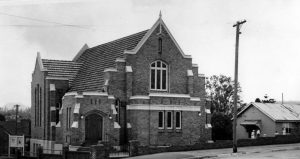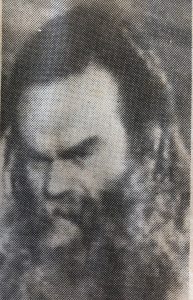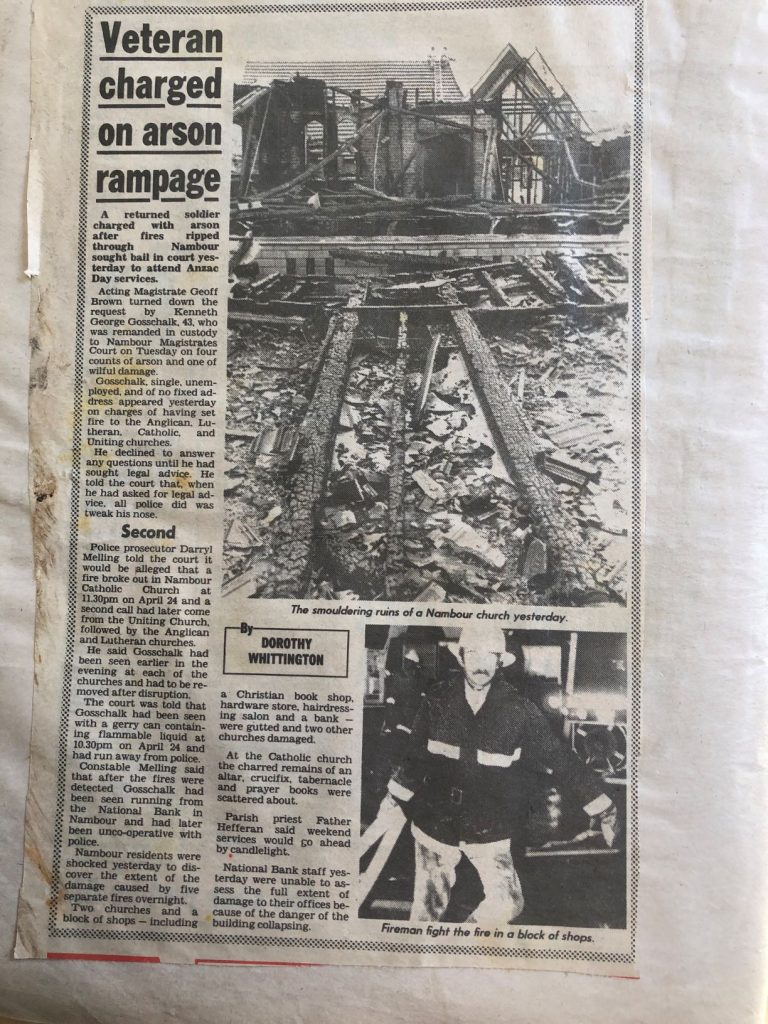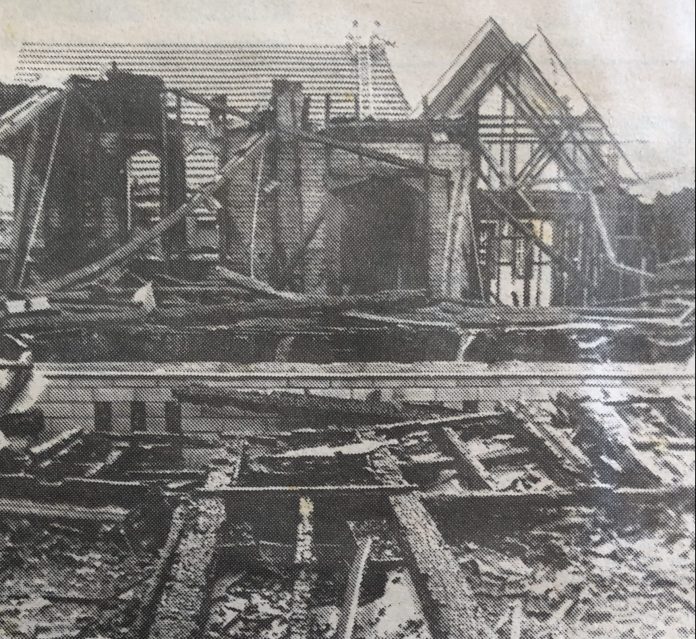It was just before midnight on the eve of Anzac Day, 1987, when the phone rang.
“Nambour’s burning,” the caller shrieked. From the hills of Burnside, an eerie red glow could be seen spreading over the sugar town.
By the time I arrived on the scene, fire officers were already hard at work trying to save the blazing Methodist Church at the intersection of Currie and Maud Streets.
Further up Currie St, the interior of the Catholic Church was alight and the Lutheran Church around the corner in Sydney St was also alight and covered in anti-Nazi graffiti. Fires at the Anglican Church and Catholic Church had failed to take hold but not without damage.

Word quickly spread that the National Bank and shops at the corner of Queen St and Lowe St were burning and that the Presbyterian Church at Coronation Avenue had also been targeted.
There were no mobile phones but the small crowd of shocked onlookers who had gathered were aghast as news spread that it was Nambour churches at the centre of the carnage. Flames and smoke filled the air as police and SES volunteers began blocking off key streets.
A fifth fire had been started in a Christian bookshop and spread to the adjacent hair salon, hardware store and the National Australia Bank. The block of shops was gutted.
By the time the Anzac Dawn Services began a few hours later, the majestic Methodist Church, a landmark for the town, was nothing but a pile of blackened rubble, never to rise again.
Kenneth George Gosschalk, a 43-year-old Vietnam veteran (pictured below), had been seen with a jerry can containing flammable liquid at 10.30pm on Friday, April 24 but had run away from police. Later, he was seen running from the National Bank in Lowe St. He was apprehended on his way to St Andrews Presbyterian Church.

He had started at the Anglican Church at the top of Currie St before making his way across to St. Joseph’s Catholic Church and down to the Methodist Church and around the corner to the Lutheran Church, which was also vandalised.
Gosschalk appeared in Nambour Magistrate’s Court on Anzac Day, initially charged with four counts of arson and one of wilful damage. His request for bail to attend memorial services was denied.
Single, unemployed and of no fixed address, with a long history of mental health problems, he declined to answer questions without legal advice, saying that when he had asked for legal advice, all police did was tweak his nose. He also said he had a friend who was a QC.
The court heard that a fire had broken out in Nambour Catholic Church at 11.30pm on April 24, and a second call had later come about the Methodist Church, followed by the Anglican and Lutheran churches.
Gosschalk had been seen earlier in the evening at each of the churches and had to be removed after disruption.
At the Catholic Church, the charred remains of an altar, crucifix, tabernacle and prayer books were scattered about but the priest, Fr Frank Hefferan, declared weekend services would go ahead by candlelight.
National Bank staff were unable to assess the full extend of damage to their offices because of the danger of the building collapsing.
On April 27, Gosschalk was transferred to Boggo Road maximum security prison, after setting his cell at the Nambour Watchhouse alight. One cell was damaged when a wash basin was ripped from the wall and water pipes broken.
The cell was flooded and the prisoner transferred to a padded cell which had only a mattress and a blanket. Gosschalk asked to use the toilet in an adjoining cell, where he removed a cigarette lighter belonging to another prisoner.
He was later seen throwing the lighter from the window of his cell and a padded wall was on fire.
In all, he was charged with 10 counts of arson and two of wilful damage.
Gosschalk was dishevelled when he appeared in court. He was bare chested, beltless, and his trousers were rolled up above his knees. He told the court he had not been fed and “it was cold in there with no clothes, no bedding, no mattress and no food. I needed a fire to keep me warm.”
Police said he had no clothing as he had used it to set fire to the watchhouse and that he had been fed. He was transferred to Brisbane for his own safety.
Love nostalgia? So do we. Help keep more great Coast memories alive by subscribing to our free daily news feed. Go to Subscribe at the top of this story and add your name and email. It’s that simple.
Born in Gladstone on October 8, 1943, Gosschalk graduated from Duntroon and was a qualified civil engineer. He served with the Royal Australian Engineers in Vietnam in 1968-69, leaving the Army with the rank of Major. He was demoted to Captain in 1976.
In 1982, he was the first Australian to be deported from Kiribati and was also deported from the Solomons, Nauru and Vanuatu and was a prohibited person on Nauru Airlines.
Kiribati police said he was first brought to the island of Banaba from Christmas Island where he had been working for the federal government, when he “went strange”. He had appeared in court on numerous charges, some involving firearms, and there were indications of mental instability. He was an explosives expert and considered dangerous.
“When I heard he had turned to religion I began hoping he wouldn’t do anything dangerous,” a long-time Australian friend at Kiribati said.
By the end of April 1987, Nambour was picking up the pieces and Gosschalk was at the Wacol psychiatric hospital. He never stood trial and died in about 1999.
This flashback is brought to you by veteran Sunshine Coast journalist and history writer Dot Whittington, also the editor of Your Time Magazine.






